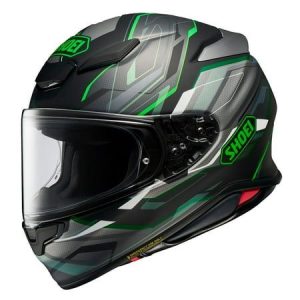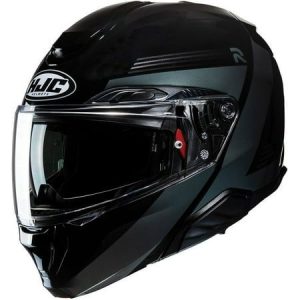When it comes to motorcycle safety, there’s no single piece of equipment more crucial than your helmet. It’s the shield that protects your head in the event of an accident, and a properly fitted helmet can mean the difference between walking away unscathed and sustaining serious injuries.
But with a vast array of motorcycle helmets available, from full-face to open-face, choosing the right one can feel overwhelming. Don’t worry, this guide will equip you with all the knowledge you need to pick the perfect motorcycle helmet for your riding style and head shape.
Motorcycle Helmet Types: Understanding Your Options
The first step is familiarizing yourself with the different types of motorcycle helmets available. Each offers varying levels of protection and caters to specific riding styles:

-
Full-Face Helmet: This helmet offers the most comprehensive protection, covering your entire head, face, and jaw. It’s ideal for riders who prioritize safety, particularly those who ride at high speeds or long distances.
-
Modular Helmet (Flip-Up Helmet): This helmet combines the safety of a full-face helmet with the convenience of an open-face helmet. The chin bar flips up, allowing for easier drinking, eating, or conversation during breaks.
-
Open-Face Helmet (3/4 Helmet): Open-face helmets offer less protection than full-face helmets, leaving the face exposed. They’ popular for short, leisurely rides due to the increased ventilation and open feel. However, their safety limitations make them a less suitable choice for highway riding.
-
Dual-Sport Helmet: Designed for both on- and off-road riding, dual-sport helmets offer a good balance between protection, ventilation, and a wider field of view. They typically feature a peak visor for deflecting dirt and debris.
Consider your riding style and the level of protection you prioritize when choosing a helmet type. Full-face helmets provide the most safety, while open-face helmets offer a more open feel but less protection. Modular helmets offer a compromise, while dual-sport helmets cater to off-road enthusiasts.
Sizing Up: Ensuring a Perfect Fit
A motorcycle helmet’s effectiveness hinges on a snug, secure fit. A helmet that’s too loose won’t protect you properly in a crash, while a helmet that’s too tight can be uncomfortable and lead to headaches. Here’s how to ensure a perfect fit:

-
Measure Your Head: Measure the circumference of your head just above your eyebrows and around the largest part of the back of your head. Consult the manufacturer’s size chart to find the corresponding helmet size.
-
Try Before You Buy: While online shopping offers convenience, it’s crucial to try on a helmet before purchasing. Visit a reputable motorcycle shop and try on different sizes and brands to find one that fits comfortably snug.
-
The Snug Test: Once you have a helmet that feels like the right size, put it on and gently rock your head from side to side. The helmet should feel snug and secure, with minimal movement. The cheek pads should press gently against your cheeks, and the helmet shouldn’t pinch your forehead.
-
The Cheek Pad Check: Open the visor and try to slide your cheeks in and out of the helmet. They should move slightly, but the helmet shouldn’t shift on your head.
-
The Snug Sniff Test: Close the visor and snug the chin strap. Try to breathe through your nose. You should feel some pressure, but you shouldn’t be able to easily pull the helmet off your head.
A properly fitted helmet should feel snug but comfortable, with no pressure points. It should stay securely in place even when you move your head, and the visor should open and close smoothly.
Safety First: Certifications and Ratings
While a snug fit is essential, look for helmets that meet safety standards set by reputable organizations. In the United States, the two most common certifications are:

-
DOT (Department of Transportation): The minimum safety standard for motorcycle helmets in the US.
-
SNELL Memorial Foundation: A non-profit organization that conducts more rigorous testing than DOT. SNELL-certified helmets typically offer a higher level of protection.
While DOT certification is the legal minimum, consider opting for a SNELL-certified helmet for enhanced safety.
Features for Function and Comfort
Once you’ve narrowed down your options based on type, fit, and safety certifications, consider the features that enhance your riding experience:
-
Visor: Look for a visor that offers a clear, undistorted view and is scratch-resistant. Consider features like an anti-fog coating for better visibility in varying weather conditions and a quick-release system for easy swapping.
-
Ventilation: Proper ventilation is crucial for keeping your head cool and comfortable during long rides. Look for helmets with multiple intake and exhaust vents that allow for optimal airflow.
-
Liner: The helmet’s liner is responsible for wicking away sweat and keeping your head dry. Removable and washable liners are ideal for maintaining hygiene and freshness.
-
Shield Lock: A shield lock prevents the visor from accidentally opening while riding, ensuring your vision remains unobstructed.
-
Weight: Lighter helmets are generally more comfortable for extended rides, reducing neck strain.
-
Communication Systems: For riders who prefer to stay connected, consider helmets that integrate seamlessly with communication systems like Bluetooth headsets.
Prioritizing Your Needs: Think about the features that are most important to you. If you ride frequently in hot weather, prioritize good ventilation. If clear visibility is paramount, choose a high-quality, scratch-resistant visor.
Material Matters: Understanding Motorcycle Helmet Construction
Motorcycle helmets are typically constructed from two main materials:

-
Thermoplastic Resin (Polycarbonate): An affordable and lightweight option that offers good impact protection.
-
Composite Fibers (Fiberglass, Kevlar): Provide superior strength and impact absorption compared to polycarbonate but come at a higher price point.
Finding the Right Balance: Consider your budget and riding style. Polycarbonate helmets are a good choice for casual riders, while composite fiber helmets offer the best protection for serious riders.
Keeping Your Investment Safe: Motorcycle Helmet Care and Maintenance
A motorcycle helmet is a significant investment, and proper care extends its lifespan and ensures optimal performance. Here are some essential maintenance tips:

-
Cleaning: Regularly clean the visor and helmet exterior with a mild soap solution and lukewarm water. Avoid harsh chemicals or abrasive cleaners that can damage the surface.
-
Liner Care: Remove and wash the motorcycle helmet liner according to the manufacturer’s instructions. A clean liner prevents the buildup of sweat and bacteria, keeping your helmet fresh and comfortable.
-
Storage: Store your helmet in a cool, dry place away from direct sunlight. Excessive heat can damage the helmet’s materials and compromise its effectiveness.
-
Inspection: Regularly inspect your helmet for signs of wear and tear, such as cracks, scratches, or loose components. If you notice any damage, replace your helmet immediately.
Following these simple care and maintenance tips ensures your motorcycle helmet remains in top condition, providing optimal protection for years to come.
Finding Your Perfect Ride Companion
Choosing the right motorcycle helmet is an essential step to ensuring your safety and comfort on the road. By considering your riding style, head shape, and the features that matter most to you, you can narrow down your options and find the perfect helmet for your needs. Remember, prioritize safety by opting for a helmet with a snug fit and proper safety certifications. Don’t hesitate to invest in a high-quality helmet – it could be the difference between a minor inconvenience and a life-altering event.

